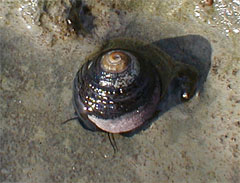Facts About Tegula funebralis
Tegula funebralis, commonly known as the black turban snail or black tegula, is a medium-sized marine snail that stands out in the eastern Pacific Ocean. Belonging to the Tegulidae family, this species was previously known as Chlorostoma funebralis. The snails possess shells typically ranging from 20 to 50 mm in diameter and can live remarkably long lives, anywhere from 7 to 30 years. An intriguing fact about these snails is the discovery of a unique chemoreceptor organ called a "bursicle" in 1971.
Black turban snails are abundantly found along the Pacific coast of North America, from British Columbia down to Baja California. In some places, such as near Monterey, California, their population density can reach up to 1,400 snails per square meter. They thrive in rocky intertidal zones, feeding on rock-encrusting algae, macroscopic algae, and organic detritus.
However, life isn't without challenges for these snails—they face numerous predators, including sea stars, crabs, octopuses, seagulls, and sea otters. When confronted with danger, black turban snails employ several effective escape tactics, such as fleeing or detaching from steep surfaces to evade predators.
Humans have been consuming black turban snails for over 12,000 years. Archaeological evidence indicates that about 3,000 years ago, the harvesting of these snails increased significantly. They became a major food source for native populations in certain regions, likely due to their abundance and ease of collection.

 Canada
Canada